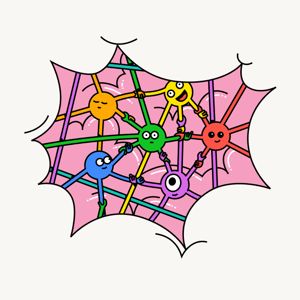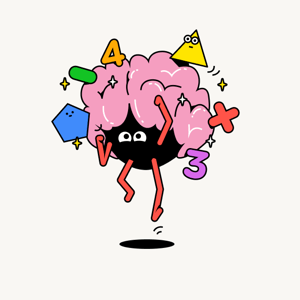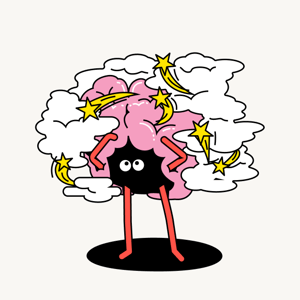The most exciting findings to come from research in recent years uncover some important aspects to learning that might surprise you! There are many myths in the world of math education that continue to leave many children unable to access the great joy and empowerment from mastering the subject. Fortunately, research in math education can help to uncover the best way to support your children to flourish in their math learning. Here are four popular myths of math learning and information on how Struggly – a web based math learning platform – can help!
Myth #1: There is such thing as a “math brain”.
 We know it is common to hear people say, “I’m just not a math person”, but the truth is, there’s no such thing!1 Everyone can be a math person, thanks to neuroplasticity (i.e. the brains ability to form and reorganize synapse connections as a result of learning). Many of us have heard about the concept of a growth mindset– the belief that our abilities are not fixed at birth– rather, that we can learn, grow, and adapt. One neuroscience study found that simply knowing about neuroplasticity helped students develop a growth mindset and the benefits that comes with it.2 Another study showed that children with a growth mindset tend to pay more attention to mistakes, and have greater accuracy in fixing mistakes.3
We know it is common to hear people say, “I’m just not a math person”, but the truth is, there’s no such thing!1 Everyone can be a math person, thanks to neuroplasticity (i.e. the brains ability to form and reorganize synapse connections as a result of learning). Many of us have heard about the concept of a growth mindset– the belief that our abilities are not fixed at birth– rather, that we can learn, grow, and adapt. One neuroscience study found that simply knowing about neuroplasticity helped students develop a growth mindset and the benefits that comes with it.2 Another study showed that children with a growth mindset tend to pay more attention to mistakes, and have greater accuracy in fixing mistakes.3
Your child’s entire Struggly experience is themed around growth mindset principals, with mindset messaging throughout the platform in the mistakes messages they recieve, and the badges they earn. Our adaptive task scheduling algorithm ensures that your child is offered tasks that are right at the end of their understanding– with the encouragement and support for them to struggle and persist through.
We know that it is difficult for those in the role of “teacher” to know exactly how to teach and promote a growth mindset. This is where the Struggly parent guide really shines! While your child is logged into struggly on a desktop, laptop, or tablet, you can also be logged in to the parent guide on your own device or phone. The parent guide will update in real time with messages, questions, and hints you can say to your child to reinforce growth mindset messages, encourage their struggle without taking away the challenge, and provide just the right amount of help.
Myth #2: In math, it’s important to avoid mistakes.
 Turns out, mistakes are actually the best learning opportunities! Making mistakes is part of the process of learning– especially in mathematics. The more mistakes we make– and learn from– the greater depth of understanding we develop. In learning environments that have a positive error climate, meaning, making errors is expected and welcomed, research shows that children tend to have more positive reactions to mistakes and make greater effort overall.4 Fear of mistakes shuts down intuitive and creative thinking in mathematics, which can eventually result in children becoming reliant on help and guidance. When children are free to make mistakes, they are also free to think and explore new ideas. Research shows that embracing mistakes leads to more learning.3
Turns out, mistakes are actually the best learning opportunities! Making mistakes is part of the process of learning– especially in mathematics. The more mistakes we make– and learn from– the greater depth of understanding we develop. In learning environments that have a positive error climate, meaning, making errors is expected and welcomed, research shows that children tend to have more positive reactions to mistakes and make greater effort overall.4 Fear of mistakes shuts down intuitive and creative thinking in mathematics, which can eventually result in children becoming reliant on help and guidance. When children are free to make mistakes, they are also free to think and explore new ideas. Research shows that embracing mistakes leads to more learning.3
We call our app Struggly because we are all about embracing moments of struggle and mistakes as learning opportunities. As your child works through our challenging mathematics tasks, they will be encouraged to struggle and their mistakes will be celebrated as learning opportunities. Your child will earn badges for creativity, strategy, and persistence as they learn and grow.
We know that it can be hard to know what to say or do to support your when they are struggling. Sometimes, it feels like the best thing to do is to show them how to get the right answer. But in actuality, this takes away the learning opportunity. Struggly features a guide for parents that runs simultaneously to whatever your child is working on. The guide provides you with suggestions and hints for how to support your child through their struggle, without removing the challenge completely.
Myth #3: To learn math, focus on numbers and equations.
 For some of us, the quintessential vision of mathematics is a smattering of numbers and symbols across a chalkboard (try doing a google image search on the word!). But mathematics in the real world is so much more than that! Mathematics is about recognizing and generalizing patterns, connecting ideas with visual representations, justifying an argument with reasons and proof, thinking creatively, and so much more! In fact, neuroscience research has found that math thinking and learning is grounded in the visual processing center of our brain.5 That means that simply focusing on numbers and symbols is not enough! Instead, the highest achieving people are the ones with the most connected brains, or multiple representations of the same concept.
For some of us, the quintessential vision of mathematics is a smattering of numbers and symbols across a chalkboard (try doing a google image search on the word!). But mathematics in the real world is so much more than that! Mathematics is about recognizing and generalizing patterns, connecting ideas with visual representations, justifying an argument with reasons and proof, thinking creatively, and so much more! In fact, neuroscience research has found that math thinking and learning is grounded in the visual processing center of our brain.5 That means that simply focusing on numbers and symbols is not enough! Instead, the highest achieving people are the ones with the most connected brains, or multiple representations of the same concept.
At Struggly, our tasks are designed with this exact research finding in mind. We know that our brains do the best learning when multiple connections and representations are explored and understood. We design our tasks to challenge children to explore math concepts in creative and visual ways, providing lots of opportunities for making connections across representations (a.k.a. brain connections!). Take the concept of ½. A person with many brain connections about fractions can think of ½ in many different ways: one out of two items, a square shaded halfway, one cup of sugar to two cups of flour, a cookie shared by two people, three people in a family of six, and so on!
Myth #4: Math is best learned through direction instruction.
 A common way to teach math is through what is referred to as “direct instruction” or the concept of telling or presenting to the learner how to do a particular aspect of mathematics followed by a set of practice problems where the child applies what they were shown. While direct instruction is not a completely ineffective teaching method, research shows that for children ages 0-8, guided play is more impactful to their learning of early mathematics.6 These findings come form a research study called a meta-analysis which is a type of research study used to merge together the findings from all research on a particular topic, and sythentisize the ‘absolute’ effect. Guided play is characterized by three main features (1) the play is child-led, the child to has at least some choice and freedom over their play (2) the adult has a learning goal in mind as they guide the child’s play (3) the adult is responsive to the childs thinking and cues, the adult is flexible with open-ended questions, hints, and prompts in response to the child’s thinking and exploring.
A common way to teach math is through what is referred to as “direct instruction” or the concept of telling or presenting to the learner how to do a particular aspect of mathematics followed by a set of practice problems where the child applies what they were shown. While direct instruction is not a completely ineffective teaching method, research shows that for children ages 0-8, guided play is more impactful to their learning of early mathematics.6 These findings come form a research study called a meta-analysis which is a type of research study used to merge together the findings from all research on a particular topic, and sythentisize the ‘absolute’ effect. Guided play is characterized by three main features (1) the play is child-led, the child to has at least some choice and freedom over their play (2) the adult has a learning goal in mind as they guide the child’s play (3) the adult is responsive to the childs thinking and cues, the adult is flexible with open-ended questions, hints, and prompts in response to the child’s thinking and exploring.
Struggly is guided play! Our tasks are child-led: the first level of each task serves as a tutorial where the child learns the challenge of the task and the rules of play, simply by trying it out! The parent guide ensures that you are aware of the learning goal of the task and prepared with questions, hints, and prompts that are relevant to how your child is responding to the task.
Catching these four myths in action can be useful learning opportunities and Struggy can help prove to you and your child that they just aren’t true. We hope that you have found this information helpful as wish you Happy Struggling!
1 Chestnut, E. K., Lei, R. F., Leslie, S. J., & Cimpian, A. (2018). The myth that only brilliant people are good at math and its implications for diversity. Education sciences, 8(2), 65.
2 Sarrasin, J. B., Nenciovici, L., Foisy, L. M. B., Allaire-Duquette, G., Riopel, M., & Masson, S. (2018). Effects of teaching the concept of neuroplasticity to induce a growth mindset on motivation, achievement, and brain activity: A meta-analysis. Trends in neuroscience and education, 12, 22-31
3 Schroder, H. S., Fisher, M. E., Lin, Y., Lo, S. L., Danovitch, J. H., & Moser, J. S. (2017). Neural evidence for enhanced attention to mistakes among school-aged children with a growth mindset. Developmental Cognitive Neuroscience, 24, 42-50.
4 Steuer, G., Rosentritt-Brunn, G., & Dresel, M. (2013). Dealing with errors in mathematics classrooms: Structure and relevance of perceived error climate. Contemporary Educational Psychology, 38(3), 196-210.
5 Boaler, J., Chen, L., Williams, C., & Cordero, M. (2016). Seeing as understanding: The importance of visual mathematics for our brain and learning. Journal of Applied & Computational Mathematics, 5(5), 1-6.
6 Skene, K., O’Farrelly, C. M., Byrne, E. M., Kirby, N., Stevens, E. C., & Ramchandani, P. G. (2022). Can guidance during play enhance children’s learning and development in educational contexts? A systematic review and meta-analysis. Child Development.
![]() This article was provided by Struggly’s team of teachers, researchers, designers, and parents. Struggly is on a mission to help children love math – by seeing it as a creative, visual subject. We call our web app Struggly to encourage children to struggle, which is known to increase brain activity. Struggly gives children tools to approach math effectively, and parents the support they need to facilitate these opportunities for their children. Our tasks are designed with research in mind to challenge and support children to develop number sense and number flexibility – the approach to numbers that has been shown to be the difference between low and high-achieving children.
This article was provided by Struggly’s team of teachers, researchers, designers, and parents. Struggly is on a mission to help children love math – by seeing it as a creative, visual subject. We call our web app Struggly to encourage children to struggle, which is known to increase brain activity. Struggly gives children tools to approach math effectively, and parents the support they need to facilitate these opportunities for their children. Our tasks are designed with research in mind to challenge and support children to develop number sense and number flexibility – the approach to numbers that has been shown to be the difference between low and high-achieving children.
We appreciate our friends at Struggly for sharing with us this week. You can save 33% on your Struggly subscription here at the Club.


